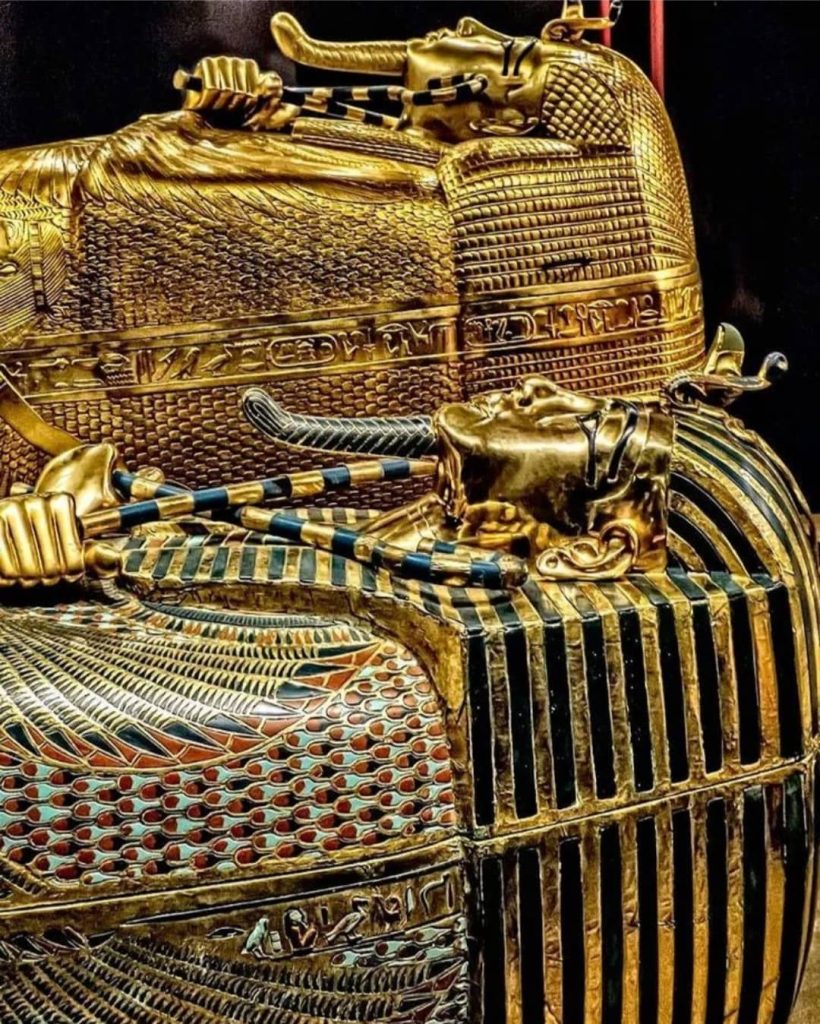In 1922, the world of archaeology was forever transformed when Howard Carter made an extraordinary discovery in Egypt’s Valley of the Kings. The tomb of King Tutankhamun, a young pharaoh of the New Kingdom’s 18th Dynasty (1332–1323 BCE), revealed treasures that astonished the modern world. Among the most iconic artifacts were the nested golden coffins, masterpieces of ancient Egyptian art and craftsmanship that also reflected profound religious beliefs.
The outer coffin, an exquisite work of art crafted from wood and gilded with gold, exemplifies the concept of divine protection. Its surface is adorned with intricate designs depicting protective deities, each symbolizing spiritual guidance for the king’s journey to the afterlife. Notably featured are Anubis, the jackal-headed god associated with mummification, and Isis, the powerful goddess of protection and magic. The coffin’s gilded surface is further enhanced by sacred hieroglyphs, meticulously inscribed spells and prayers meant to shield and guide the young pharaoh through the challenges of his eternal journey. Beyond its breathtaking beauty, the golden exterior served a dual purpose: it was both a display of the immense wealth and status of the king and a spiritual shield for his immortal soul.

Moving deeper into the tomb, the inner coffin is even more remarkable. Constructed entirely from solid gold, it cradles the mummy of King Tutankhamun himself, whose mortal body was carefully wrapped in linen and embellished with gold leaf. This inner coffin is not merely a container for the deceased; it is a work of unparalleled artistry. Every surface of the coffin bears inscriptions proclaiming Tutankhamun’s divine lineage and his eternal connection to the gods. The craftsmanship displayed is extraordinary, with intricate hieroglyphs and delicate inlays revealing the skill and dedication of the artisans of the 18th Dynasty. To this day, modern experts marvel at the level of technical expertise and attention to detail that these ancient craftsmen achieved.
These coffins hold profound cultural and spiritual significance. For the ancient Egyptians, gold was not merely a symbol of wealth but was believed to possess transformative properties that were essential for the afterlife. Every decoration, symbol, and inscription on the coffins served a deliberate spiritual purpose, ensuring the deceased’s safe passage and protection in the next world. The elaborate design and craftsmanship of these coffins reflect the complex Egyptian beliefs about death, resurrection, and eternal life. The outer and inner coffins together illustrate a worldview where death was not seen as an end, but as a transition to a higher, eternal existence.
The discovery of King Tutankhamun’s tomb and its contents has provided invaluable insights into the burial practices of ancient Egypt, particularly during the New Kingdom period. The elaborate preparation of the tomb and the extraordinary wealth of its contents underscore the importance of material resources in funeral rituals. Moreover, the detailed inscriptions and symbolic decorations on the coffins have deepened our understanding of the intricate relationship between art and religion in ancient Egyptian culture. These artifacts reveal the Egyptians’ unwavering devotion to their gods and their meticulous planning for the afterlife, ensuring that every detail served a spiritual and practical purpose.
Beyond their historical and cultural significance, the golden coffins remain enduring symbols of ancient Egyptian civilization. They continue to captivate modern audiences, drawing attention to the extraordinary achievements of a society that combined artistic excellence, religious devotion, and royal authority. Exhibited in museums and studied by scholars, these coffins offer a rare glimpse into a world that existed thousands of years ago, yet continues to inspire awe and wonder.
Today, the legacy of King Tutankhamun’s golden coffins extends far beyond their archaeological significance. They serve as a testament to the timeless allure of ancient Egypt, a civilization that viewed death as a magnificent transformation rather than an end. The coffins’ intricate artistry and profound symbolism remind us of humanity’s enduring quest to understand life, death, and the mysteries of the universe. Few artifacts in the history of archaeology have achieved such universal recognition and admiration, making the discovery of King Tutankhamun’s tomb one of the greatest milestones in the study of ancient civilizations.
As we reflect on the legacy of these treasures, we are reminded of the remarkable ingenuity and creativity of the ancient Egyptians. The golden coffins of King Tutankhamun are not just relics of a bygone era; they are enduring symbols of a people who sought to transcend mortality and achieve eternal life. Through their artistry and spiritual significance, these artifacts continue to bridge the gap between the past and the present, connecting us to the beliefs and aspirations of a civilization that has long since vanished, yet remains profoundly influential.
The nested coffins of King Tutankhamun stand as a testament to the enduring power of art, faith, and human ingenuity. They challenge us to look beyond their physical beauty and delve into the rich cultural and spiritual heritage they represent. For historians, archaeologists, and enthusiasts alike, these treasures remain a source of endless fascination, a reminder of the boundless possibilities of human creativity and the eternal quest for meaning beyond the confines of mortal life.





